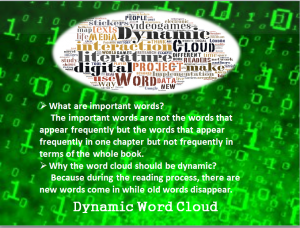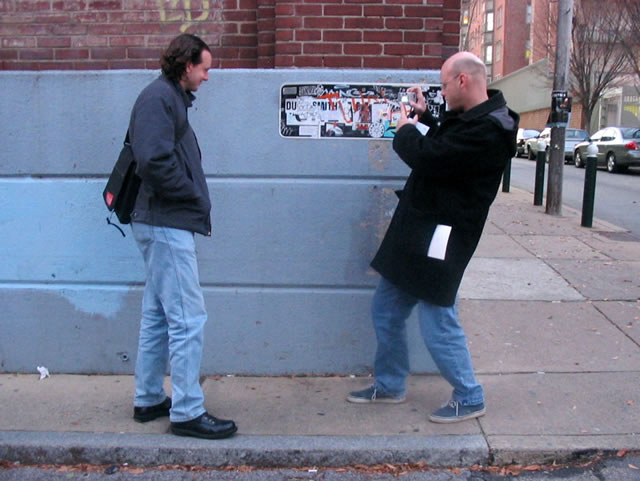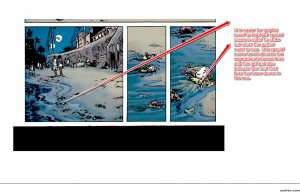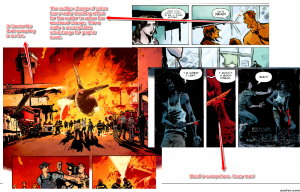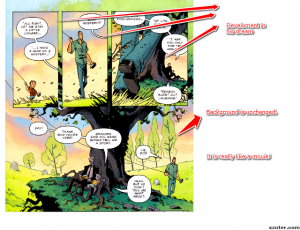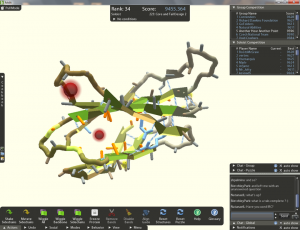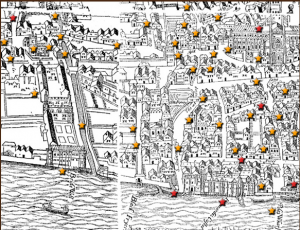Author Archives: Xin Zhang
Final Project Abstract: See more than texts
November 8th, 2013 | Posted by in Uncategorized - (0 Comments)See more than texts
With the development of computational ability, more and more literature pieces are “born-digital” or have been digitized. To have a multidimensional view of the literature, we have to develop tools to see something behind texts. In this project, I will cover the tools and projects about how to see more than texts when reading literature. Interesting topics like text visualization, data-mining will be covered. Tools and projects like Ngram Viewer, Wordle and Textarc will be introduced. And some experiments with those tools and projects will be presented. Finally, there will be some analysis about how these tools and projects change the way of literature research, how they change our attitudes toward literature and how they make us think about digital humanity. I hope that with this final project I can have a new view towards the literature in digital age.
Electronic Literature Critique: Implementation
November 4th, 2013 | Posted by in Uncategorized - (0 Comments)Electronic Literature Critique: Implementation
In the 1980’s, with the advance of computing technology, literature began to move from the printed books into computer screens. That is the birth of electronic literature. N. Katherine Hayles argues in the online article Electronic Literature: What Is It that, “electronic literature, generally considered to exclude print literature that has been digitized, is by contrast ‘digital born,’ and (usually) meant to be read on a computer.” According to the Electronic Literature Organization, electronic literature or e-lit refers to “works with important literary aspects that take advantage of the capabilities and contexts provided by the stand-alone or networked computer”. Although there are a huge amount of different forms of electronic literature, the Electronic Literature Organization gives nine categories of current electronic literature, which are “(1) E-books, hypertext fiction and poetry, on and off the Web (2) Animated poetry presented in graphical forms, for example Flash and other platforms (3) Computer art installations which ask viewers to read them or otherwise have literary aspects (4) Conversational characters, also known as chatterbots (5) Interactive fiction (6) Novels that take the form of emails, SMS messages, or blogs (7) Poems and stories that are generated by computers, either interactively or based on parameters given at the beginning (8) Collaborative writing projects that allow readers to contribute to the text of a work (9) Literary performances online that develop new ways of writing”. Implementation is the kind of electronic literature project that is a writing project that allows readers to contribute to the work.
Implementation is a project about how texts resonant with their environment. The authors put their book chapters on stickers and then distribute those stickers to individuals. Instructions which encourage people to peel the stickers off and place them in public area are along with those stickers. Then the authors collect the images of those sheets of stickers and put those imagines online. Those images which are photographed by the readers at different placements give us an idea of the resonance between the texts and the environment. As written in the project’s introduction, the authors hope that “this form of interaction will engender new and unanticipated meanings as Implementation is situated in specific public spaces that resonate with the texts in different ways.”
In my opinion, the most fantastic thing about Implementation lies in the interactivity. There are four kinds of people who participate in this project. The first kind is the “sheet readers” who have the sheets of stickers, read the texts and distribute those stickers. The second kind is the people who read those stickers in public area. And then there may be some “web readers” who want to know more about the book or the project by going to the website. The most important is the “participants” who read those stickers in public area, post the stickers they have, photograph those stickers according to their will and send those images back to the authors. It is those participants that make the whole project have interactivity because they decide the “interface” of the book and the way texts resonate with environment by photographing in different ways and at different conditions. This is a novel idea for interactivity. In the “classic” electronic literature such as Michael Joyce’s afternoon: a story, the interaction is achieved by hypertexts’ linking structures. In kinetic poems (such as City Story), chatterbots (such as Because You Asked) and interactive fictions (such as Knotted Line), the interactivity is achieved by the game element which means that the reader’s different reactions cause different but programmed consequences. However, the interactivity in Implementation is not achieved by either the linking structures of hypertexts or the programmed game elements. In Implementation the interactivity is achieved by the decision of the participants . The participants decide the places the stickers are situated, the way the images are photographed, the resonance between the texts and the environment. Unlike hypertext fictions in which every link is read in isolation, the stickers in Implementation function in a whole as a coherent narrative. The readers who see the stickers can have access to the whole story by viewing the website to see the texts or images. Instead of using game elements which result in programmed consequences according to the reader’s reaction, the consequences in Implementation are not programmed and are totally undetermined until the reader post imagines online. This is the real interactivity instead of “inter-passivity”. This also offers a new way for collaborative writing.
Although the Implementation is an excellent electronic literature project, there are some aspects that can be improved from my point of view. The first one I would like to improve is how to show the places where the stickers are situated. In the current project, all the images are listed according to placement. This cannot give the reader a specific sense of how the stickers are distributed. It would be great if the stickers can be marked on a map just like what is done in the project Skin. In the project Skin, the literature pieces are written on the skin of volunteers with a map to show the place of each literature piece. From the map, the reader can easily explore the geographic features of literature. In the project Implementation, a map will be a great tool to find some resonance between the texts and geographic locations. The second improvement is about the way to show the images. In the current project, the images are not just listed according to the location name. It would be better to use some interactive way to show these images. For example, in the project the Knotted Line, the interactive way of reading makes the reader have a sense of development and a sense of uncovering story. For the similar reason, in Implementation, an interactive interface can give the reader a sense of the shift of geographic locations. That may cause some unanticipated meaning about the resonance between the texts and the environment.
In summary, the project Implementation is an electronic literature project that uses collaborative writing to allow readers to contribute to the work. The interactivity in Implementation is different from the hypertexts and game elements in other electronic literature projects. This collaborative writing way has unpredictable consequences instead of programmed consequences when interacting with the readers. It would be better if the project can improve aspects about the interactive interface on the website.
CITATION:
Implementation, http://nickm.com/montfort_rettberg/implementation/
N. Katherine Hayles, Electronic Literature: What Is It, http://eliterature.org/pad/elp.html
Electronic Literature Organization, http://eliterature.org/
Michael Joyce, afternoon: a story (Watertown MA: Eastgate Systems, 1990)
City Story, http://luckysoap.com/entreville/index.html
Because You Asked, http://www.cddc.vt.edu/journals/newriver/07Spring/bigelow/BecauseYouAsked.html
Knotted Line, http://knottedline.com/
Skin, http://ineradicablestain.com/skin.html
Daytripper: You Are the Lucky Survivor
October 28th, 2013 | Posted by in Uncategorized - (0 Comments)Daytripper is the first graphic novel in my life. The first impressive thing is its special features that are incompatible compared with other media. Here are four most impressive features:
I. Capture of the most important moment:
Graphic novel can ignore the flow of time to frozen a special moment for the author to express opinion. For example, Daytripper the moment when Bras was shot to death to say his opinion about life. It is really amazing to hear a dying man’s opinion about what is the most important thing in life.
II. Highlight special scene:
The author select a special scene without considering the spacial scale in order to show some indications. In Chapter 2 of Daytripper, the small toy is used as an indication to show that Bras has been drown. And this is also a indication to show that Bras and the girl are separated forever.
III. Use colors to show augmenting reality:
1) emotion: The sudden change of color shows a big contrast of emotion change.
2) environment: The red color is full of the page. It seems that everything is on fire.
3) action: At the moment when the man cut himself the page gets red. It strikes out a bloody and crazy action.
IV. Show timeline in a 2-D medium:
In the picture shown above, the development of dream is shown as pictures. But the background is unchanged during this development. This is like a movie. This makes graphic novel have time line.
The second thing that makes me impressive is the theme of Daytripper. In the dream, Bras died at the important moments of his life: in his father’s birthday party, on the way to find the girl the loves, the moment when his son was born etc. It really makes the reader feel sorry for him. But is Bras everyone. He is not special. As shown in the picture below, every elements in hie life are the same as us. Maybe we will die at a party or on the way to find someone we love. What if we die so easily like Bras? Should we live a life like now? Will we know what is the most important thing of our life? The fact is that we could die at any moment. We live a short life. We are the “Daytripper”. People keep dying everyday, but we survive. We are the lucky one who are still breathing the air, who can still see the world, who can talk to people we love. So try to live as if we are the lucky survivor because we do not have much time. God does not tell us when we will die. Enjoy every moment when we are still breathing.
Last Friday we had a chat with two scholars about media archaeology. This chat was really inspiring and was also the first chat I had with scholars who do not have major in natural sciences. In the chat, the two scholars showed some examples about media archaeology, explained the research methods used in media archaeology and the relations between media archaeology and culture. What really impressed me was the discussion about whether the carriers should be treated as a part of media.
Just as the theme of the article “Geology of Media” in The Atlantic, these two scholars believe that media is not only data. The media is made of the combination of data and the carriers. They gave us some examples such as the study of book design and research the location of factory to show how to study media archaeology by the study of the information carriers. I agree with them that the carriers were the part of media in old age before the coming of digital age. Of course the material of a book shows the information a author want to tell the readers. But the situation is not the same as digital age is converting everything into digital numbers. When we are reading digital books, the materials are always the computer screen. As for the information carriers, it does not matter whether data were stored in CDs or in hard drives or in clouds. Because data are just 1’s and 0’s. It is meaningless now to study media while caring about the carriers in digital age because you are not computer scientists or physicists who are working to develop better information carriers. However, I am not denying that it is very useful to study the media before digital age by study of information carriers. I am just believing that the carriers is becoming less and less important with everything being digitalized.
In the end, I would like to share a interesting video Garbage doesn’t lie (http://www.youtube.com/watch?v=KI-sGVwC4yE) which has some similarity with the geology of media. I think that should be called “garbage archaeology”.
Novel response: the Difference Engine
October 16th, 2013 | Posted by in Uncategorized - (0 Comments)What would happen if there were computers in Victorian Britain? The difference engine as a typical work of steampunk is a novel that answers this question. In this novel, the authors, William Gibson and Bruce Sterling, assumes that Charles Babbage not only succeeded in developing his difference engine, a steam-powered machine that can do calculation but also made it have the analytical ability. The appearance of this difference engine or a steam-powered computer changes everything from politics to art, from industrial design to scientific research, from social control to people’s lifestyle. With a machine’s appearance, an alternative history is created.
From the fictive life in the alternative history shaped by a computational machine, we can always see the life of ourselves. For example, with a number Mike can know everything about Sybil. And also with a new number, Sybil could get away from the past and become a new person. Isn’t that number our Google account or Facebook account? From our accounts on Facebook and Google, a strange man has the access to the database can know everything we do in the “Cyberspace” from what we like to watch to what we do for living, from what we look like to what our habits are, from what we did the past and what we may do in the future. With a new account, we lose the friends on Facebook or Google plus and thus we can begin a new “life” online with totally new friends and even with different digital personalities. That makes me think of Who owns the future. I begin to worry about what will big companies like Google and Facebook do with me in the future.
In scientific research, the best way to know the function of an object is to see what is the difference between the results with and without the object. We cannot let history happen again to see the function of computers. But the intelligent authors William Gibson and Bruce Sterling made it by creating an alternative history. Brian Mchale relates the novel to the postmodern interests in “finding a new way of ‘doing’ history is in fiction”. However, I think it is better to say that the novel finds a new way to reflect the reality and predict the future by a fictive story in history.
CITATION:
William Gibson and Bruce Sterling, the Difference Engine. New York: Bantam, 1991.
http://en.wikipedia.org/wiki/Steampunk
http://en.wikipedia.org/wiki/The_Difference_Engine
McHale, Brian (1992). “Difference Engine”. ANQ 5: 220–23.
Ian Miles, “The difference engine: William Gibson and Bruce Sterling 383 pages, £13.95 (London, Victor Gollancz, 1990)”, Futures, 23 525 (1991).
We live in an age when digital devices is everywhere. We live with our computers, phones, cameras that all can convert the analog signals into digital signals. In this way massive data are produced everyday which seem to be messy but can be powerful by data mining. We call this big data.
Before the discussion of big data, we have to figure out what is data. Data do not equal information. According to Merriam-Webster dictionary, Data are information that are readable to machines. Or in other words, data are collection of 0’s and 1’s that carry information. So books are not data until someone like Google digitalize them. With massive data that seem to be messy for human, the most important thing is how to make use of them. There are many projects such as Understanding Shakespeare, MoEML and Google ngram Viewer show effective ways to make use of big data by data mining and infographics.
But as for doing literature study with big data, there are some scholars like Jean-François Lyotard claim their radical idea that this will destroy the humanity behind literature. I understand their concerns but they are really overreacted. Big data is just a tool used for literature study that can gives us a different view of literature. We use big data but we do not deny the importance of human in literature study. We use Google ngram Viewer to do literature study or technically macroanalysis but that does not mean that our scholars all retire and let machines do everything. The human is always dominating the study of literature but with a modern and powerful tool to see hidden aspects that cannot be found without big data. So our scholars get a powerful tool rather than become slaves of machines.
SOURCES:
“Data.” Merriam-Webster.com. Merriam-Webster, n.d. Web. 4 Oct. 2013. <http://www.merriam-webster.com/dictionary/data>.
Understanding Shakespeare. <http://www.understanding-shakespeare.com/>
MoEML. MoEML. N.p., n.d. Web. 04 Oct. 2013. <http://mapoflondon.uvic.ca/>.
Google Ngram Viewer. Computer software. Google Ngram Viewer. N.p., n.d. Web. 04 Oct. 2013. <http://books.google.com/ngrams>.
“Literature Is Not Data: Against Digital Humanities |.” N.p., n.d. Web. 04 Oct. 2013. <http://lareviewofbooks.org/essay/literature-is-not-data-against-digital-humanities/>.
Jockers, Matthew L. “On Distant Reading and Macroanalysis.” Web log post.Matthew L Jockers. N.p., n.d. Web. 04 Oct. 2013. <http://www.matthewjockers.net/2011/07/01/on-distant-reading-and-macroanalysis/>.
Game Critique
With the development of the computational ability of machines, the videogame as an important tool for entertainment enters into everyone’s life and affects the society development directly or indirectly. Videogames, together with other traditional media like newspapers and films, carry their information and give people an extended reality while they spread information. From the view of media microecology[1], the videogame as a part of this ecology should be studied if we want to know the media ecology critically and systematically.
Are videogames media? This question has been debated for a long time by many scholars with so many people with old fashioned thinking believing that videogames designed for entertainment with interaction, computational models and digital roles should not be recognized as media. Those people ignore the impacts and nature of videogames behind the computational structures and entertainment activities. A medium is defined as “(1) a channel or system of communication, information, or entertainment — compare mass medium (2) a publication or broadcast that carries advertising (3) a mode of artistic expression or communication (4) something (as a magnetic disk) on which information may be stored”[2] in Merriam-Webster dictionary. It is obvious that videogames are media considering that information is communicated while videogame is interacting with the player and this information always reflects the designers’ thinking about space and time, life and death, justice and evil, society and nature, and so on. In addition, the videogame is a much more powerful medium compared with traditional media that can only affect people by texts, sounds and images. In a videogame, one can interact with the computational program; can experience a virtual life with their avatar in it; can live in a universe that has totally different rules from the real one. With the computational model, digital roles and interaction with players, videogames have huge amount of users and are more widespread compared with traditional media which can be easily seen from the download frequency of videogames and the region of gamers and the amount of games in everyone’s smart phone. Not everyone likes reading Hamlet but everyone likes playing Angry Birds; New York Times is not popular in every country but Angry Birds is popular everywhere in the world.
The videogame like other medium has its own diversity and extends from purely artistic uses to purely instrumental uses. It is true that some videogames are full of violence. But not all! The violence in films is no less than that in videogames. We should see the whole situation and give a critical opinion towards videogames. The videogame as a medium is a platform for designers to show their opinions and thinking about life and about world by means of computational models. For example, games like Flow and Cloud try to make the player have a slow pace when playing. That is the designer’s attitude toward life. With the simple structure and slow pace, Flow and Cloud tell us to take a low pace and enjoy the simple life. Videogames have unmatchable advantages over other media as for conveying new ideas about space and time. Portal and Braid are the two typical representations of games that give the players a total new concept about space and time. In Portal, the player uses the gun to create holes on walls to change the space structure of the world. Going into the hole, the player will shift to another space linked by holes. And in Braid, time can be controlled by the player. The player can learn from the past and uses the new concept of time to complete missions impossible for normal time sequence. Besides entertainment, videogames can be practical and used as instrumental tools in many cases. The simulation games like flight simulator are well known for their function for training pilots and soldiers. Scientists have realized the power of games and they have designed many serious games to help solve scientific problems by the collective intelligence of massive players all over the world. For example, Foldit is designed by the biology scientists in order to find new structures of proteins that could be useful in medicine design. In this game, the player design structures of proteins according to the rules and the system will score every structure. The structures that earn high scores are studied by the scientists to see if they have special properties. And many research accomplishments have been got by this way.
Fig. 1. A screenshot of the game Foldit.
“Medium is message”. Regardless the contents of a videogame, the videogame itself is an object that is informative and should be studied. “Gamespace is everywhere.”[3] The word “gamespace” is induced by the videogames. In videogames, what players do is to compete with others to earn high scores. What players do is just obey the rules and make use of the rules to do activities that have been programmed before. Is that like some people’s life? For some people, they go along the way that has been designed by their parents or themselves years before. That kind of life is programmed just like what the designers do to games. The real difference between real life and games lies in the fact that things happen in the next moment are unknown to people. That is the real meaning of life. People should abandon the “programmed” way and think about what they really want. Otherwise, they will live in a gamespace until death. Videogames invoke the thinking of life out of gamespace.
The videogame has become a new medium that comprises the media ecology with other media. As a medium, it has the common properties with other traditional media. And at the same time it has some unmatchable advantages over other media due to its computational model and ability of interaction. In order to learn more about modern media and their functions, it is necessary to study videogames critically in terms of the contents and forms.
SOURCES:
[1] Bogost, Ian. “Media Microecology.” Introduction. How to Do Things with Videogames. Minneapolis: University of Minnesota, 2011. N. pag. Print.
[2] “Medium.” Merriam-Webster.com. Merriam-Webster, n.d. Web. 28 Sept. 2013. <http://www.merriam-webster.com/dictionary/medium>
[3] Wark, McKenzie. “Agony.” Gamer Theory. Cambridge, MA: Harvard UP, 2007. N. pag. Print.
Flow: http://interactive.usc.edu/projects/cloud/flowing/
Cloud: http://thatgamecompany.com/games/cloud/
Portal: http://www.thinkwithportals.com/
Braid: http://braid-game.com/
Foldit: http://fold.it/portal/
Critique of the Map of Early Modern London
September 15th, 2013 | Posted by in Uncategorized - (0 Comments)Critique of the Map of Early Modern London
Author: Xin Zhang
Partner: Zhan Wu
The Map of Early Modern London (MoEML) is a project aimed to give users a sense of the inhabited space of London, which gave rise to the theatrical setting of many plays. Based on the Agas map, a 6-foot-2-inch woodcut of London dating from the 1560s, the project maps the streets, sites, and significant boundaries of London from 1560 to 1640 and incorporates a detailed gazetteer , topical essays, and digital texts from that period. It now comprises four main parts which are a digital atlas of Agas map, an encyclopedia of early modern London people and places, a library of mayoral shows and other texts rich in London toponyms and a forthcoming modernized edition of John Stow’s A Survey of London. And the heart of the project is an XML placeography incorporating over 720 streets, churches, wards, neighborhoods, and sites of interest. Places are both geo-referenced and linked to the Agas Map in order to visualize the locations in texts of the period.
By mapping literary references, the MoEML project would provoke research questions about Shakespeare and London alike. “How typical is Shakespeare’s invocation of London? How do his characters move through the urban environment? What is the relationship between London and the Court in Shakespeare’s historical vision? How does his geographical vision compare to that of other playwrights, such as Thomas Heywood, and to that of historians like Holinshed and Stow?” These questions entail a reconstruction of the historical space. As the director of the project Jenstad says: “think about the influences on authors, I’m thinking about the streets they lived in, where they shopped, where they went for entertainment, the route they must have taken to walk down to the bookseller who published their book, the specific environment in which people bought the book.”
Figure. 1. Part of the Agas map marked with stars. The places marked with red stars are ones that have been edited as entries in the encyclopedia. The places marked with yellow stars are ones that are not written into the encyclopedia due to lack of knowledge.
The project invents a new way for us to study literature as it maps the places in literature and it is also a great tool to learn more about culture and history as literature is always based on some reality of that time. The researchers searched digitized texts from the 1560s for place names of early modern London and then matched those to the right places on the 1560s Agas woodcut map of London. In this way, they make use of the digitized texts with data mining programs. And they also make links to relate every place name to the texts where they are mentioned. For some places they mark red stars, the links are related to an entry of the encyclopedia for users to learn more about the history and culture about them. For some undetermined places, they will show the mark “?” to remind you that their identity may be disputed, and thus allow readers to be involved in the effort to identify them. Although it is a remarkable project, I think fails to extract deeper layers of data. It only marks the place names and links them to the related texts. However, it does not indicate all the toponyms in a specific text and their frequency. For example, when I read Richard III, I cannot grasp the distribution and frequency of the theatrical loci in the play. The project can use the current database to develop more functions than are found in the current version: it could show the places mentioned in a play and mark them according to the ; frequency referenced; it could aggregate the distribution of toponymes in the entire corpus of an author; it could show the trend of changing frequency of places being mentioned in the literature of that time to gather “narrative evidence” for the social development process. It could simply do much more.
This project makes progress by integrating cartography in the archaeology of literature. It is a useful tool for scholars to study the history and culture of early modern London and it is an attractive feature for the students to develop interest in texts. Although such a digitized Google-style map enables readers to zoom in, search and read related texts, the map is not visually appealing with only black and white colors. With the help of modern graphic technology, the map could be made colorful and three-dimensional like the Google map. In that case, it will attract a wider audience and promote learning of English history and literature among the general public.
Being open-source, the website not only provides information for other researchers but also allows users to help optimize the website. And the interface has two different versions to cater to different tastes of the users. The website seems difficult for new users as it has no manual to tell them how to make use of the website and it is not immediately clear how to use it. This is really a big mistake because such lack of accessibility turns potential users away. And it also lacks links to other relevant projects, which hinders other researchers to make cross references.
This website satisfies various criteria of an academic website. The fact that undergraduate students contributed to the project underlies its educational value. In the history of MoEML, the researchers recorded their research process which allows replication and generalization of the research procedure. It is continuously kept up to date with the latest scholarship. All the credits and citations are clearly listed which shows a good academic integrity.
The Map of Early Modern London is a creative project which highlights the spatial dimension of literature and at the same time provides indexed reference to massive amount of texts. But it has much potential of improvement.
SOURCES:
MoEML. Ed. Jenelle Jenstad. Social Sciences and Humanities Research Council, n.d. Web. 22 Sept. 2013.
Google Style Map: http://lettuce.tapor.uvic.ca/~london/imap/htdocs/
Digital Humanities 2013. Proc. of DigitalHumanities2013. N.p., n.d. Web. 03 Oct. 2013. <http://dh2013.unl.edu/abstracts/ab-180.html>.
HOWARD, JENNIFER. “The Chronicle Review.” Rev. of Literary Geospaces. Weblog post. The Chronicle of Higher Education. N.p., n.d. Web. 03 Oct. 2013. <http://chronicle.com/article/Literary-Geospaces/12442>.


